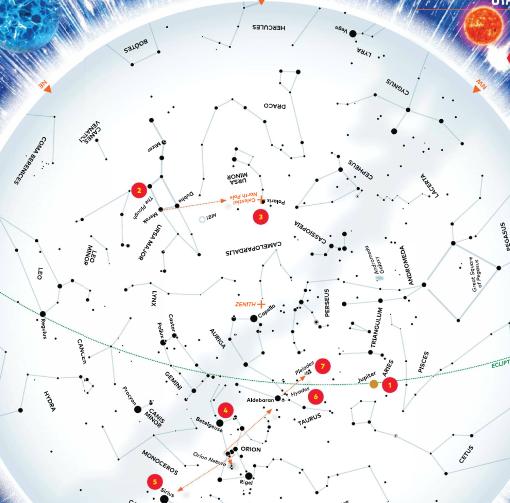
For centuries, humans have mapped the night sky, weaving patterns and stories into the heavens. These star charts reveal pathways that stargazers can follow to take a voyage across space. In February, people across the UK will be doing just that, as dark sky festivals take place up and down the country. Come with us on a tour of the night sky and discover the wonders of the cosmos.
It can get very chilly at night at this time of year, so make sure you’re dressed for the cold, with a warm coat, gloves and sturdy shoes. Step outside and find an observing spot away from the glow of street lights – be sure to ask an adult to come along if you want to go beyond your front doorstep or back garden.
When you look up, try to orient yourself on the star map (right). The map shows the whole sky as it appears around 8pm in early February (or 6pm at the end of the month). To quickly find your bearings, remember that the Sun sets in the southwest. The zenith is the point directly above your head, while the horizon forms the map’s edges. The numbers on the map mark the main stops on our tour.
Don’t worry if you can’t see much at first – your ability to see faint stars improves as your eyes get used to darkness, so try to block direct light sources (if all else fails, use an umbrella). Now, you’re all set.
1 Jupiter
This story is from the Issue 71 edition of The Week Junior Science+Nature UK.
Start your 7-day Magzter GOLD free trial to access thousands of curated premium stories, and 9,000+ magazines and newspapers.
Already a subscriber ? Sign In
This story is from the Issue 71 edition of The Week Junior Science+Nature UK.
Start your 7-day Magzter GOLD free trial to access thousands of curated premium stories, and 9,000+ magazines and newspapers.
Already a subscriber? Sign In

Are cats smarter than dogs?
They're the UK's top pets, but which is more intelligent? You decide!

Could people turn Mars into another Earth?
Sven Bilén explores how humans might make a home on another world.

FUNNY BY NATURE
Claire Karwowski tracks down the wackiest wildlife that's cracking up the animal kingdom.

WEIRD SCIENCE
A round-up of the strangest science stories from around the world.

Guardians of the forest
Meet the incredible people protecting the Amazon rainforest.

The Mariana Trench
Dive in to find out how far down the ocean goes and what it's really like at the bottom.

Megan McCubbin
Meet the zoologist trying to change people's views of animals with a bad rep.

MAX POWER
From the second you wake up in the morning, your way of life is made possible thanks to the amazing power of electricity.

Your heart has a "brain"
New research by scientists at Sweden, and Columbia University, in the US, suggests that your heart could have its own \"mini brain\".

Ethiopian wolves could be furry pollinators
Sweet-toothed Ethiopian wolves have been seen lapping up nectar have been seen happing up nectar from red hot poker flowers.